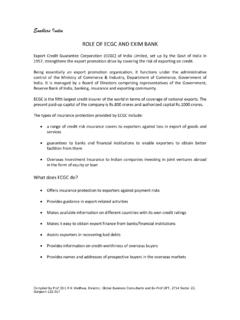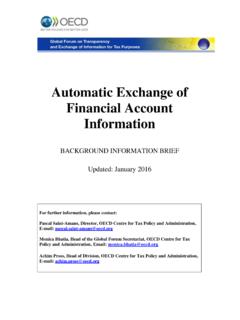Transcription of Development Finance Institutions: Profitability …
1 Development Finance Institutions: Profitability Promoting Development * Thomas Dickinson Development Finance still plays a critical role in financing private enterprise in Africa and should be further promoted as an important complement to overseas aid. Development Finance institutions are cost-effective for donor countries and efficiency-enhancing for countries where deployed. DFI partnerships with private investors in project Finance are a rich potential source of devel-opment externalities.
2 What are DFIs? Development Finance institutions (DFIs) occupy an intermediary space between public aid and private investment, facilitating international capital flows in the words of the Chief Executive of CDC, Britain s DFI (formerly the Common-wealth Development Corporation). Distinct from aid agencies through their focus on profitable investment and operations according to market rules, DFIs share a common focus on fostering economic growth and sustainable Development . Their mission lies in servicing the investment shortfalls of developing countries and bridging the gap between commercial investment and state Development aid.
3 DFIs provide a broad range of financial services in developing countries, such as loans or guaran-tees to investors and entrepreneurs, equity par-ticipation in firms or investment funds and fi-nancing for public infrastructure projects. DFIs will initiate or develop projects in industrial fields or in countries where commercial banks are reticent about investing without some form of official collateral. DFIs are also active in fi-nancing small and medium-size enterprises, supporting micro loans to companies, often viewed as too risky by private sources of financ-ing.
4 A benefit of this approach is that DFIs often find themselves with first-mover advantage in markets with strong growth potential. A case in point is the famous African experience of Celtel telecommunications company, where DFIs in-vested early as part of their developmental char-ter and later found themselves ending with enormous profits. DFIs depend on profits from their investments to ensure resources for further engagements. Cur-rently, this model is proving successful, with in-stitutions such as CDC or the European Bank for Reconstruction and Development (EBRD) out-performing emerging market indices (see Box 1 below).
5 Bilateral Development Finance institutions are majority-owned by national governments and have historically served to implement govern-ment foreign Development and co-operation policies. Multilateral DFIs, also known as inter-national Finance institutions (IFIs), usually have greater financing capacity and provide a forum for close co-operation between governments. Both types of institutions retain operational in-dependence from their funding governments. Backed by government funds and guarantees ensuring their credit-worthiness, DFIs can raise large amounts of funds on international capital markets to provide loans or equity investment on competitive, even subsidised, terms.
6 Box 1: DFIs are outperforming Britain's CDC showed a return of 33% in 2007 outperform-ing the global Emerging Markets Bond Index (EMBI) by 20% The consolidated portfolio of European DFIs at year end 2006 reached billion, up from billion in 2005. Table 1: Development Finance Institutions Risk & Investment Practices Through their developmental mission and public funding, DFIs have, by definition, a higher risk tolerance and a longer investment horizon.
7 DFIs can call upon the guarantees of the state and are free from the short-term constraints of pri-vate investors. Thus, DFIs have the capacity to make long-term investments at attractive rates in markets to which the private sector find too risky to commit. Furthermore, DFIs pay no cor-porate tax or dividends1. Bilateral DFIs tend to make partnerships with the private sector in developing countries, while the regional Development banks (see Table 1) generally focus primarily on loans to the public sector ( via sovereign loans for commercially run public enterprises).
8 The Asian Development Bank also has major exposure to equity invest-ments in the private sector. The EBRD provides direct investment on commercial terms to public and private sector projects, such as backing in-frastructure plans, but also large commercial ventures in its region of specialisation (Eastern Europe through to Central Asia). The financial support DFIs bring to relatively high-risk projects is intended to serve as a cata-lyst, helping to attract and mobilise the involve-ment of other sources of private capital. In addi-tion, Development banks often act in co-operation with governments and other organisa-tions in providing funds for management consul- 1 Only dividend paid out was FMO and Proparco be-cause these are part-owned by private banks.
9 In EBRD, a dividend was discussed, but rejected in fa-vour of a grant fund. Source ODI, interviews with EBRD officials. tancy and technical assistance, and serving as channels for policy implementation in areas such as governance, compliance with environmental regulations, good business practices and sustai-nability. DFIs involvement can serve to mitigate risk, serving as a public guarantee in countries and sectors where private sector actors would be unwilling to operate alone. Their public status allows DFIs to make longer maturity loans at good interest rates, advantageous guarantees and undertake high-risk equity investment.
10 DFIs may also help lower the cost of capital for firms through partial credit risk guarantees. 01000200030004000500060007000 AFDBCDCNIBPROPARCOIADBADBDEGFMOMIGAEIBOP ICEBRDIFCF igure 1. DFI commitments to the private sector, 2005to developing countries, USD million Source: Based on Overseas Development Institute, 2007 The IFC and EBRD are by far the biggest DFIs in terms of annual commitments to the private sector (see figure 1). Some concentrate primarily on loans (EIB, Proparco) others primarily on eq-uity (CDC). The equity portion within the total portfolio of European DFIs reached 52 per cent in 2006, up from 41 per cent in 20052, a signifi-cant shift away from loan Finance towards equity stakeholding.


















